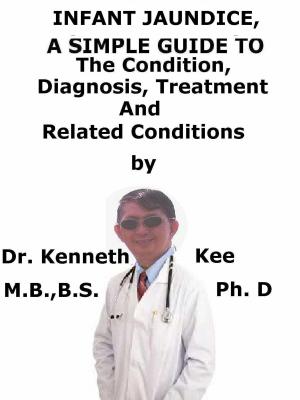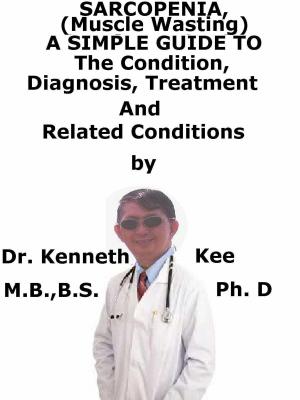Infection Of Helicobacter Pylori, A Simple Guide To The Condition, Diagnosis, Treatment And Related Conditions
Nonfiction, Health & Well Being, Medical, Specialties, Internal Medicine, Gastroenterology, Health, Ailments & Diseases, Abdominal| Author: | Kenneth Kee | ISBN: | 9781370927463 |
| Publisher: | Kenneth Kee | Publication: | November 17, 2016 |
| Imprint: | Smashwords Edition | Language: | English |
| Author: | Kenneth Kee |
| ISBN: | 9781370927463 |
| Publisher: | Kenneth Kee |
| Publication: | November 17, 2016 |
| Imprint: | Smashwords Edition |
| Language: | English |
Helicobacter pylori infection is a medical disorder in which a bacterium (H. pylori) that can infect the lining of the duodenum and stomach.
It is one of the most frequent infections even though it is getting less common as time goes by.
More than 25% people in the world become infected with H. pylori at some stage in their life.
The moment the patient is infected, unless treated, the infection normally stays for the rest of the life.
Infection with H. pylori is the reason for producing most stomach and duodenal ulcers.
H. pylori also produce non-ulcer dyspepsia in some patients.
It can also induce gastric cancer.
Infection with H. pylori can be confirmed by:
1. A test done on a sample of feces (stools),
2. A breath test
3. A blood test,
4. A biopsy sample taken during an endoscopy
A one-week course of two antibiotics plus an acid-suppressing medicine will normally cure the H. pylori infection.
This bacterium is believed to be transmitted through oral-oral or fecal-oral exposure (from eating contaminated food) from person to person.
H. pylori may be passed through human saliva and feces.
It is therefore frequent where sanitation is poor.
The signs and symptoms when present are:
a. Nausea
b. Vomiting
c. Abdominal pain
d. Heartburn
e. Diarrhea
f. Hunger in the morning
H. pylori infection may produce:
1. Stomach and duodenal ulcers
2. Non-ulcer dyspepsia
3. Stomach cancer
Laboratory tests can detect H. pylori infection:
1. Carbon 13 urea breath test
2. H pylori fecal antigen test:
H. pylori bacteria are killed by certain antibiotics.
A combination of medicines is needed to clear it completely.
The patient needs to take two antibiotics at the same time.
Also, the patient needs to take a medicine to reduce the acid in the stomach.
This permits the antibiotics to work well in the stomach.
The patient needs to take this combination therapy for a week.
It is essential to take all the medicines as directed and to take the full course.
Combination treatment clears H. pylori in up to 90% cases if it is taken correctly for the full course.
Other medicines used in the treatment of H pylori infection are:
1. Anti-diarrheals (e.g., bismuth subsalicylate)
2. Proton pump inhibitors (e.g., lansoprazole, omeprazole)
3. H2-receptor blockers (e.g., ranitidine, famotidine)
While peptic ulcer disease is the most studied disease linked to H pylori infection, this bacterium is seems to be involved in the genesis of several extra-gastric diseases:
1. Mucosa-associated lymphoid tissue lymphomas (MALTomas),
2. Coronaritis (inflammation of coronary arteries),
3. Gastroesophageal reflux disease (GERD),
4. Iron deficiency anemia,
5. Skin disease,
6. Rheumatologic conditions.
TABLE OF CONTENT
Introduction
Chapter 1 Helicobacter pylori Infection
Chapter 2 Causes
Chapter 3 Symptoms
Chapter 4 Diagnosis
Chapter 5 Treatment
Chapter 6 Prognosis
Chapter 7 Gastritis
Chapter 8 Gastric Cancer
Epilogue
Helicobacter pylori infection is a medical disorder in which a bacterium (H. pylori) that can infect the lining of the duodenum and stomach.
It is one of the most frequent infections even though it is getting less common as time goes by.
More than 25% people in the world become infected with H. pylori at some stage in their life.
The moment the patient is infected, unless treated, the infection normally stays for the rest of the life.
Infection with H. pylori is the reason for producing most stomach and duodenal ulcers.
H. pylori also produce non-ulcer dyspepsia in some patients.
It can also induce gastric cancer.
Infection with H. pylori can be confirmed by:
1. A test done on a sample of feces (stools),
2. A breath test
3. A blood test,
4. A biopsy sample taken during an endoscopy
A one-week course of two antibiotics plus an acid-suppressing medicine will normally cure the H. pylori infection.
This bacterium is believed to be transmitted through oral-oral or fecal-oral exposure (from eating contaminated food) from person to person.
H. pylori may be passed through human saliva and feces.
It is therefore frequent where sanitation is poor.
The signs and symptoms when present are:
a. Nausea
b. Vomiting
c. Abdominal pain
d. Heartburn
e. Diarrhea
f. Hunger in the morning
H. pylori infection may produce:
1. Stomach and duodenal ulcers
2. Non-ulcer dyspepsia
3. Stomach cancer
Laboratory tests can detect H. pylori infection:
1. Carbon 13 urea breath test
2. H pylori fecal antigen test:
H. pylori bacteria are killed by certain antibiotics.
A combination of medicines is needed to clear it completely.
The patient needs to take two antibiotics at the same time.
Also, the patient needs to take a medicine to reduce the acid in the stomach.
This permits the antibiotics to work well in the stomach.
The patient needs to take this combination therapy for a week.
It is essential to take all the medicines as directed and to take the full course.
Combination treatment clears H. pylori in up to 90% cases if it is taken correctly for the full course.
Other medicines used in the treatment of H pylori infection are:
1. Anti-diarrheals (e.g., bismuth subsalicylate)
2. Proton pump inhibitors (e.g., lansoprazole, omeprazole)
3. H2-receptor blockers (e.g., ranitidine, famotidine)
While peptic ulcer disease is the most studied disease linked to H pylori infection, this bacterium is seems to be involved in the genesis of several extra-gastric diseases:
1. Mucosa-associated lymphoid tissue lymphomas (MALTomas),
2. Coronaritis (inflammation of coronary arteries),
3. Gastroesophageal reflux disease (GERD),
4. Iron deficiency anemia,
5. Skin disease,
6. Rheumatologic conditions.
TABLE OF CONTENT
Introduction
Chapter 1 Helicobacter pylori Infection
Chapter 2 Causes
Chapter 3 Symptoms
Chapter 4 Diagnosis
Chapter 5 Treatment
Chapter 6 Prognosis
Chapter 7 Gastritis
Chapter 8 Gastric Cancer
Epilogue















